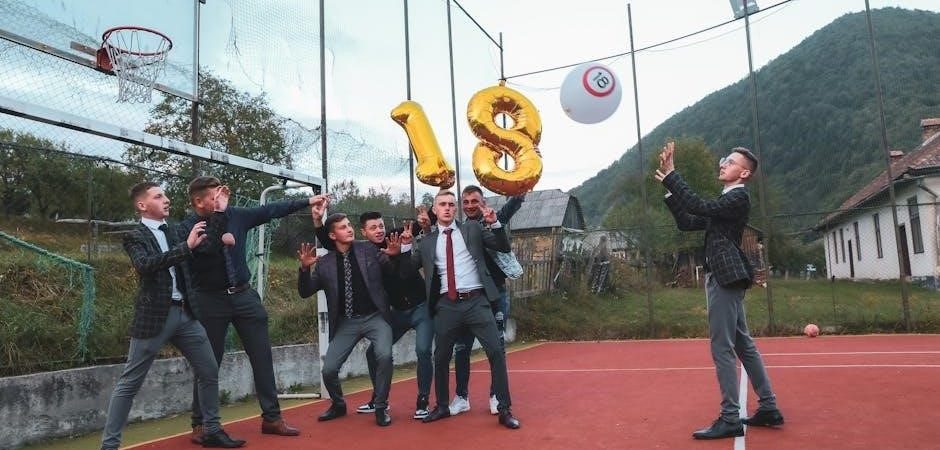
Luis Valdez’s Zoot Suit is a groundbreaking musical drama set in 1940s Los Angeles, exploring racial tensions, the Zoot Suit Riots, and the Sleepy Lagoon murder case. This play, available as a PDF, blends music, drama, and myth, offering a powerful commentary on social justice and Chicano identity, making it a seminal work in American theatre history.
1.1 Historical Context of “Zoot Suit”
The play Zoot Suit is set in 1940s Los Angeles amid racial discrimination and social unrest. The Zoot Suit Riots of 1943, where servicemen clashed with Mexican-American youths, and the Sleepy Lagoon murder case, which wrongly accused young Chicanos, form the historical backbone. These events symbolized the deep-seated prejudices and injustices faced by Mexican-Americans during World War II. Valdez’s work captures the tension between cultural identity and societal marginalization, using these events to explore themes of racial profiling and resistance. The play bridges history and drama, offering a powerful commentary on systemic inequality and the resilience of the Chicano community.
1.2 Overview of the Play’s Significance
Zoot Suit holds a landmark position in Chicano theatre, being the first Chicano play to reach Broadway in 1979. It signifies a cultural breakthrough, blending drama, music, and myth to address racial profiling and social injustice. The play not only highlights the struggles of Mexican-Americans during WWII but also serves as a powerful tool for cultural preservation and identity. Its mix of historical events and artistic expression makes it a pivotal work in American theatre, influencing future playwrights and solidifying its place in the legacy of Chicano literature and performance art.

Plot Summary
“Zoot Suit,” set in 1940s Los Angeles, centers on Henry Reyna and the pachucos, exploring racial tensions, the Sleepy Lagoon trial, and cultural identity through drama and music.
2.1 The Storyline of “Zoot Suit”
Zoot Suit is set in 1940s Los Angeles and revolves around Henry Reyna, a young Chicano man, and his friends, known as pachucos, who face racial discrimination and societal marginalization. The play intertwines factual events, such as the Sleepy Lagoon murder trial and the Zoot Suit Riots, with fictionalized narratives to highlight the struggles of Mexican-American youth. Through a blend of drama, music, and myth, the storyline explores themes of identity, resistance, and the clash between cultural traditions and societal expectations. El Pachuco, a mythical figure, serves as a guiding force, urging Henry to confront injustice and reclaim his community’s pride.
2.2 Key Events and Turning Points
The play centers on the Sleepy Lagoon murder trial, where Henry Reyna and his friends are wrongly accused of murder. A pivotal moment occurs when El Pachuco, a mythical figure, persuades Henry to embrace his cultural identity and resist oppression. The Zoot Suit Riots, sparked by tensions between servicemen and Mexican-American youths, further escalate racial conflict. In court, the defense battles systemic racism, while the community rallies for justice. These events highlight the struggle for equality and the resilience of the Chicano community, marking a turning point in their fight against injustice and societal marginalization.

Themes of the Play
Zoot Suit explores themes of social justice, racial profiling, and cultural identity, set against the backdrop of the Zoot Suit Riots and World War II. It delves into the struggles of the Chicano community, blending historical drama with myth, and highlights the fight against systemic racism and oppression, emphasizing the importance of cultural pride and resilience in the face of adversity.
3.1 Social Justice and Racial Profiling
Luis Valdez’s Zoot Suit addresses systemic racism and injustice through the Sleepy Lagoon murder case and the Zoot Suit Riots. The play portrays the trial of Henry Reyna, highlighting racial profiling and discrimination against Mexican-Americans during WWII. The storyline exposes how societal prejudice and misinformation fueled violence against the Chicano community. By dramatizing these events, Valdez critiques the legal system’s bias and the marginalization of minority groups. The character of El Pachuco symbolizes resistance, urging the community to stand against oppression. The play underscores the enduring struggle for social justice and equality, resonating with contemporary issues of racial profiling and discrimination.
3.2 Cultural Identity and Community
Zoot Suit celebrates Chicano cultural identity, emphasizing the vibrant traditions and resilience of the Mexican-American community. The play uses music, language, and costume to explore the unique blend of Mexican heritage and American influences in 1940s Los Angeles. Henry Reyna’s journey reflects the struggle to maintain cultural pride amidst societal pressure and discrimination. El Pachuco, a symbolic figure, embodies the spirit of the zoot suiters, fostering unity and resistance within the community; The play highlights the importance of cultural expression as a form of empowerment, showcasing the strength and solidarity of the Chicano people during a time of adversity.
3.3 Historical Drama and Reality
Zoot Suit intertwines historical events with dramatic storytelling, blending reality and fiction to depict the 1940s Los Angeles milieu. The play draws from the real-life Sleepy Lagoon murder case and the Zoot Suit Riots, which sparked racial violence and injustice. By dramatizing these events, Valdez sheds light on the systemic discrimination faced by Mexican-Americans during World War II. The fusion of historical facts with theatrical elements creates a compelling narrative that educates audiences about a pivotal moment in American history while maintaining artistic integrity and emotional depth, making the past relatable and impactful for contemporary viewers.
Characters
El Pachuco, a symbolic figure, guides Henry Reyna, the protagonist, while other characters like the 38th Street gang members and the Judge play pivotal roles in the story.
4.1 El Pachuco: The Symbolic Figure
El Pachuco is a mythical figure embodying the spirit of the zoot suiters, symbolizing rebellion and cultural pride. He serves as a mentor to Henry Reyna, urging resistance against societal oppression. Through his charismatic presence and sharp wit, El Pachuco represents the collective identity of the Chicano community, blending folklore with reality. His role is both symbolic and narrative, guiding the story while reflecting the broader struggles of Mexican-Americans during the 1940s. His influence is central to the play’s exploration of identity, justice, and community resilience.
4.2 Henry Reyna: The Protagonist
Henry Reyna is the protagonist of Zoot Suit, a young Chicano leader of a group of zoot suiters. Based on real events, Henry faces an unfair trial for the Sleepy Lagoon murder, symbolizing systemic racial injustice. Guided by El Pachuco, he navigates his identity and the societal pressures imposed on Mexican-Americans during World War II. Henry’s journey reflects the struggle for justice and cultural pride, making him a powerful symbol of resistance and resilience in the face of discrimination and oppression, deeply resonating with the Chicano community’s experiences. His story is central to the play’s exploration of identity and social justice.
4.3 Other Key Characters and Their Roles
Beyond Henry Reyna and El Pachuco, other characters play vital roles in Zoot Suit. Henry’s girlfriend, Della, embodies resilience and loyalty, supporting him through his trial. The Judge and Press represent systemic oppression, highlighting racial bias in the judicial system. The Pachucos, Henry’s gang, symbolize cultural pride and resistance. Together, these characters weave a narrative of community, identity, and injustice, enriching the play’s exploration of Chicano experiences during wartime Los Angeles. Their interactions drive the story, illustrating the broader societal tensions and the struggle for justice and equality. Each character adds depth to the play’s historical and cultural context.

Cultural Significance
Zoot Suit holds profound cultural significance as a landmark in Chicano theatre, preserving the history of the Zoot Suit Riots and addressing racial injustice, while celebrating Mexican-American identity and resilience through its vivid portrayal of community struggle and resistance. Its impact endures as a powerful representation of cultural memory and social justice.
5.1 The Zoot Suit Riots and Their Impact
The Zoot Suit Riots of 1943 were a series of violent clashes in Los Angeles between Mexican-American youths and U.S. servicemen. The riots, sparked by racial tensions and the distinctive zoot suits worn by the youths, symbolized deeper social conflicts. The play Zoot Suit dramatizes these events, highlighting the marginalization and injustice faced by Mexican-Americans. The riots had a lasting impact, galvanizing the Chicano rights movement and becoming a symbol of resistance against racial profiling and discrimination. The play’s portrayal of these events ensures their memory and significance are preserved for future generations.
5.2 The Play’s Role in Chicano Theatre
Zoot Suit is a landmark in Chicano theatre, marking the first Chicano play to reach Broadway in 1979. It brought Chicano stories and struggles to mainstream audiences, blending music, drama, and cultural identity. The play’s success paved the way for future Chicano playwrights, challenging stereotypes and celebrating Mexican-American heritage. Its innovative style, combining myth and reality, redefined Chicano theatre, making it a cornerstone of the movement. By addressing racial injustice and cultural pride, Zoot Suit remains a powerful symbol of Chicano resilience and artistic expression, continuing to inspire new generations of artists and audiences.
5.3 Cultural Memory and Representation
Zoot Suit preserves the cultural memory of Mexican-Americans during the 1940s, highlighting their struggles and resilience. The play vividly portrays the Zoot Suit Riots and the Sleepy Lagoon murder case, ensuring these events are not forgotten. By blending myth and reality, it honors the vibrant identity of the Chicano community. The character of El Pachuco embodies the spirit of resistance, while Henry Reyna’s story humanizes the experiences of marginalized youth. As a PDF, the play remains accessible, educating future generations about this pivotal moment in American history and the enduring strength of Chicano culture. Its representation fosters empathy and understanding, keeping memories alive.

Playwright Luis Valdez
Luis Valdez, a renowned Chicano playwright, created Zoot Suit to address racial injustice and celebrate Mexican-American culture. His work revolutionized Chicano theatre and storytelling.
6.1 Biography and Background
Luis Valdez was born in 1940 in Delano, California, to a family of migrant workers. His early life shaped his commitment to Chicano rights and cultural preservation. Valdez studied at San Jose State University, where he developed his writing skills. He co-founded El Teatro Campesino in 1965, producing plays that addressed farmworkers’ struggles and Chicano identity. This activism laid the groundwork for Zoot Suit, which became a landmark in Chicano theatre, blending drama, music, and myth to tell powerful stories of social justice and cultural resilience.
6.2 His Influence on Chicano Literature
Luis Valdez’s work revolutionized Chicano literature by giving voice to the experiences of Mexican Americans. Through Zoot Suit and other plays, he challenged stereotypes and highlighted social injustices. His blend of drama, music, and cultural mythology created a unique theatrical style that resonated nationally. Valdez’s influence extended beyond theatre; he inspired a generation of Chicano writers and artists to explore their heritage and advocate for social change. His contributions paved the way for Chicano literature to gain recognition and legitimacy on mainstream stages, ensuring its enduring impact on American cultural discourse.
6.3 Other Works and Contributions
Beyond Zoot Suit, Luis Valdez has authored numerous plays, poems, and essays that explore the Chicano experience. Notable works include Bandido! and I Don’t Have to Show You My Papers, which further showcase his ability to blend cultural themes with compelling narratives. Valdez has also contributed to film and television, expanding his reach beyond theatre. His writings often address identity, social justice, and the struggles faced by Mexican Americans. These works, including Zoot Suit, are widely studied and celebrated, cementing Valdez’s legacy as a pivotal figure in Chicano arts and literature.

Performance History
Zoot Suit premiered at the Mark Taper Forum in 1978, making it the first Chicano play on Broadway. Its 1979 Broadway run and 50th-anniversary revival highlighted its cultural impact and enduring relevance.
7.1 Broadway Production and Reception
Luis Valdez’s Zoot Suit made history as the first Chicano play on Broadway in 1979. Produced by the Center Theatre Group, it opened at the Taper Forum in 1978 before transferring to Broadway. The production received critical acclaim for its bold storytelling, blending drama, music, and cultural identity; Audiences and critics praised its innovative style and powerful exploration of social justice. The Broadway run solidified its place in American theatre history, marking a significant milestone for Chicano literature and performance.
7.2 Revivals and Modern Performances
Zoot Suit has seen numerous revivals, ensuring its relevance endures. A 2018 production at the Mark Taper Forum celebrated the play’s 40th anniversary, reuniting original cast members. In 2019, the Selma Arts Center staged it, directed by Juan Luis Guzmán, highlighting its continued resonance. Modern performances blend the original’s energetic music and drama, appealing to new generations. These revivals underscore the play’s importance in preserving Chicano cultural memory and its ability to connect past injustices with contemporary social issues, solidifying its legacy as a powerful theatrical experience.
7.3 Notable Actors and Their Roles
Daniel Valdez, the playwright’s brother, originally portrayed Henry Reyna, bringing depth to the protagonist’s struggle. Edward James Olmos famously played El Pachuco, embodying the zoot suiter’s spirit. In the 2018 revival, original cast members reunited, showcasing their enduring connection to the play. These actors’ performances have been pivotal in shaping the play’s identity, blending drama with cultural authenticity. Their roles not only highlighted the story’s emotional core but also cemented the play’s place in theatre history, ensuring its messages resonate with audiences today. Their contributions remain integral to Zoot Suit’s legacy.
Style and Structure

Zoot Suit uniquely blends drama with musical elements, using myth and reality to narrate its story. The play’s structure incorporates vibrant stage designs and symbolic costumes, emphasizing cultural identity and historical context through its artistic style.
8.1 Blend of Drama and Musical Elements
Luis Valdez’s Zoot Suit masterfully combines drama and music, creating a vibrant narrative. The play’s musical elements, including traditional Mexican songs and lively choreography, enhance the emotional depth of the story. These elements not only reflect the cultural heritage of the characters but also serve to underscore key themes such as resistance and identity. The integration of music and dance transforms the play into a dynamic and engaging theatrical experience, making it a landmark production in Chicano theatre. This blend of genres ensures the play’s continued relevance and appeal to diverse audiences.
8.2 Use of Myth and Reality
Luis Valdez’s Zoot Suit seamlessly blends myth and reality, creating a unique theatrical experience. The character of El Pachuco serves as a mythical figure, symbolizing the spirit of the zoot suiters and their cultural identity. While the play is rooted in real historical events, such as the Zoot Suit Riots and the Sleepy Lagoon murder case, Valdez incorporates mythical elements to explore broader themes like resistance and social justice. This fusion of myth and reality not only enhances the narrative but also highlights the play’s cultural significance and universal appeal. The interplay between the two creates a powerful and thought-provoking drama.
8.3 Stage Design and Costumes
The stage design for Zoot Suit captures the vibrant streets of 1940s East Los Angeles, blending barrio culture with the tensions of the era. Costumes play a central role, particularly the iconic zoot suits, which symbolize rebellion and identity. The exaggerated suits, with their broad shoulders and tapered pants, are both a statement of pride and a target for discrimination. The stage often features bold colors and dynamic set pieces, reflecting the energy of the community. These visual elements enhance the play’s themes of cultural identity and social justice, immersing the audience in the world of the zoot suiters.

Critical Reception
Zoot Suit received critical acclaim for its cultural significance and blend of drama and music, though some critics noted controversial elements. Its Broadway debut marked a historic milestone.
9.1 Reviews and Acclaim
Zoot Suit received widespread acclaim for its bold storytelling and cultural significance. Critics praised its blend of drama, music, and myth, hailing it as a landmark in Chicano theatre. The play’s Broadway debut in 1979 marked a historic milestone, earning praise for its unflinching portrayal of racial injustice and its vibrant celebration of Mexican-American identity. Audiences and reviewers alike commended its innovative style, with many noting its importance in bringing marginalized voices to the mainstream stage. The play’s success at the Mark Taper Forum and subsequent Broadway run solidified its reputation as a groundbreaking work in American theatre history.
9.2 Controversies and Criticisms
Despite its acclaim, Zoot Suit faced criticism for its portrayal of certain historical events. Some argued that the play oversimplified the complexities of the Zoot Suit Riots and the Sleepy Lagoon murder case. Critics noted that the blending of fact and fiction sometimes blurred the line between historical accuracy and artistic license. Additionally, the play’s depiction of the Pachucos and their culture sparked debates, with some accusing it of romanticizing aspects of the Pachuco lifestyle. These critiques, however, did not diminish the play’s impact but rather highlighted the challenges of representing sensitive historical events on stage.
9.3 Scholarly Analysis and Interpretations
Scholars have praised Zoot Suit for its cultural significance and historical depth. The play is often analyzed as a landmark in Chicano theatre, blending myth and reality to address systemic racism and identity. Academic discussions highlight its use of the zoot suit as a symbol of resistance and cultural pride. The character of El Pachuco is interpreted as an embodiment of collective consciousness, guiding Henry Reyna’s fight for justice. The play’s availability as a PDF has facilitated its study in classrooms, fostering discussions on racial profiling and community resilience. Its enduring relevance underscores its importance in exploring themes of identity and social justice.

Educational Resources
The Zoot Suit play is widely available as a PDF, along with study guides and teaching materials, making it accessible for educational purposes and scholarly analysis.
10.1 Availability of the Play in PDF
Zoot Suit by Luis Valdez is widely available in PDF format, enabling easy access for students, educators, and researchers. This digital version preserves the original script’s integrity, including dialogue, stage directions, and musical elements. The PDF format allows for convenient downloading and sharing, making it a valuable resource for studying Chicano theatre and its historical context. Many online platforms offer the play for free or through academic subscriptions, ensuring its accessibility for educational purposes and scholarly analysis.
10.2 Study Guides and Teaching Materials
Study guides and teaching materials for Zoot Suit are widely available, offering educators and students a comprehensive understanding of the play’s themes, historical context, and cultural significance. These resources include detailed analyses of key scenes, character studies, and discussion questions, helping to facilitate classroom exploration. Many guides focus on the play’s representation of social justice, racial profiling, and Chicano identity, making them invaluable for teaching diverse perspectives. Additionally, some materials provide historical background on the Zoot Suit Riots and their impact, enriching the learning experience and encouraging critical thinking about the play’s relevance today.
10.3 Online Discussions and Forums
Online discussions and forums about the Zoot Suit play provide a platform for sharing insights, analyses, and resources. Many users discuss the play’s historical context, such as the Zoot Suit Riots, and its cultural significance. Forums often include links to the PDF version of the play, study guides, and scholarly articles. Educators and students frequently exchange ideas about teaching materials and interpretations of key themes like social justice and identity. These online spaces foster a community of learners and enthusiasts, promoting deeper understanding and appreciation of Valdez’s work and its relevance to contemporary issues.

Legacy of the Play
Zoot Suit left an indelible mark on Chicano theatre, inspiring future playwrights and solidifying its place in American cultural history, with its PDF widely studied and performed today.
11.1 Impact on Chicano Theatre Movement
Luis Valdez’s Zoot Suit revolutionized Chicano theatre by bringing Mexican-American stories to mainstream stages, challenging stereotypes and fostering cultural pride. As the first Chicano play on Broadway in 1979, it marked a historic milestone, inspiring a wave of Chicano playwrights to explore their heritage. The play’s success bridged gaps between communities, emphasizing the importance of racial justice and cultural identity. Its enduring influence is evident in its continued performances and availability as a PDF, ensuring its educational and artistic impact endures, solidifying its role in the Chicano Theatre Movement’s legacy.
11.2 Influence on Future Playwrights
Luis Valdez’s Zoot Suit significantly influenced future playwrights by showcasing the power of blending cultural identity, history, and art. Its innovative mix of drama, music, and myth inspired a generation of Chicano and Latino writers to explore their heritage. The play’s success demonstrated the viability of producing works centered on marginalized voices, encouraging others to address social justice and cultural themes. As a widely studied text, available as a PDF, it continues to educate and inspire playwrights, reinforcing its legacy as a transformative work in American theatre and ethnic literature.
11.3 Continued Relevance in Modern Society
Zoot Suit remains a powerful commentary on issues still prevalent today, such as racial profiling, social injustice, and cultural identity. The play’s exploration of systemic discrimination resonates with contemporary movements like Black Lives Matter, highlighting ongoing struggles for equality. Its themes of community resilience and resistance continue to inspire dialogue about marginalization and empowerment. Available as a PDF, the play serves as a vital educational tool, connecting historical events to modern societal challenges, ensuring its relevance and impact endure across generations.
Luis Valdez’s Zoot Suit remains a landmark work, blending music and drama to explore social justice and identity. Its legacy endures, inspiring Chicano theatre and cultural dialogue.
12.1 Summary of Key Points
Luis Valdez’s Zoot Suit is a powerful musical drama rooted in the 1940s Zoot Suit Riots and the Sleepy Lagoon murder case. The play explores themes of racial injustice, cultural identity, and community resilience. Its blend of drama, music, and myth, along with its vibrant characters like El Pachuco and Henry Reyna, has made it a landmark in Chicano theatre. As the first Chicano play on Broadway, Zoot Suit has left a lasting legacy, inspiring dialogue on social justice and cultural memory. Its availability as a PDF ensures continued educational and theatrical relevance.
12.2 Final Thoughts on the Play’s Importance
Luis Valdez’s Zoot Suit remains a vital work in American theatre, offering a poignant reflection on racial injustice and cultural identity. Its historical context, coupled with its artistic innovation, ensures its relevance today. The play’s ability to blend drama, music, and myth creates a unique storytelling experience, making it a cornerstone of Chicano theatre; As a PDF, it continues to educate and inspire, fostering dialogue on social justice and the importance of preserving cultural memory. Zoot Suit is not just a play; it is a testament to the resilience of a community and a call for equality.